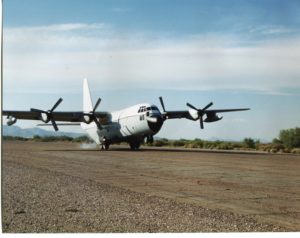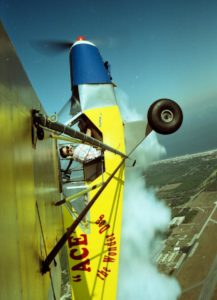The Tailwheeler’s Journal # 15
Prop-smacking, part 2
In the preceding Journal, we pointed out how difficult it is to ding the prop while at full takeoff power with lots of forward stick. Now let’s take a look at the EASY way to get your prop:
If you watch some air show performers, you’ll see that they will sometimes taxi up to show center with the tail in the air, then bow to the crowd. The airplane is stopped, it’s obviously developing a lot of power and the tail comes up causing the prop to move to within inches of the ground. This maneuver uses three controls to change the pitch of the airplane. Lots of power is used, depending on the wind force and direction. The brake is used, either dragging while taxiing tail-up or locked if the plane is stopped and bowing. Elevator is critical and its use must be very precise. Screw up one of those inputs or fail to compensate with another and the prop may become a backhoe.
The technique above may not be one that you’ll practice, but a variation of it is what a well-trained pilot will use in a short field landing. And under those same circumstances, an under-trained pilot will fail to use the resources available to him to keep his prop out of the dirt.
When an airplane is decelerating we’ve got the throttle closed. That leaves brake and elevator. I think either of them can be the culprit if the nose gets too low.
I’ve watched a couple of videos on YouTube that show props getting smacked. In the majority of them, it appeared to me that elevator was not used to maintain pitch. I hate to second guess other pilots, but that’s what it looked like to me.
I consider elevator the primary pitch control in a braking, decelerating stop with the tail in the air. But if you run out of elevator your braking will cause the plane to pitch down, so you’ve GOT to get off the brake (have you read
about “aviation braking snobbism” in “Brian’s Flying Book”? If so, you know that I believe we should be proficient in the use of brakes).
If you fail to control pitch with either brake or elevator, it’s probably because you weren’t aware of your precise pitch. That’s usually caused by lack of proper concentration and not looking far enough away.
I consider mastery of tail-up taxiing or quick stopping to be the sign of a well-qualified pilot. Like many operations it takes practice. The Whuffos at my former airport always assumed I was showing off with this maneuver. Whuffos don’t understand the difference between showing off and practicing. That’s what makes them Whuffos. I will also admit that I don’t teach the technique very often. I can protect my students through most maneuvers by over riding their control inputs. One thing I can’t do, though, is reduce their brake input. If they mash that brake and I run out of elevator we’re going to have some bent tips. That’s why I have to admit that I usually urge practice of this technique in someone else’s airplane.
Happy Swooping!
Brian



